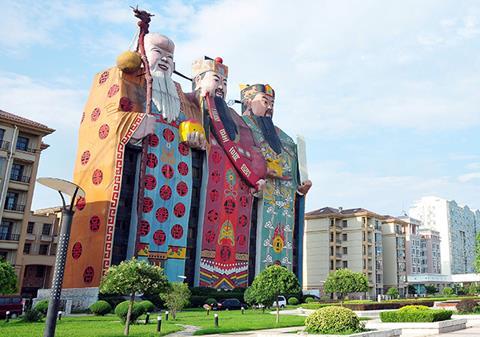China’s president recently called for an end to ‘weird architecture’ resulting from the construction boom, which could be good news for British designers

When a recent trade delegation visited from China we treated four of them to dinner at the local gastro pub. Each studied the menu hard, but would not make a decision until the party leader made his choice, they then had the same. We were discussing the masterplanning of an urban extension around a new Metro Station north of Chengdu and it dawned on me that key strategic decisions about the form and shape of buildings were being made in the same way as selection of main course. It boiled down to the personal preference of the guy in charge. This system can work well, but recent examples from China suggest that the local leadership does not always have the best taste.
Check out the Tianzi Hotel in Beijing (pictured below). It is a 15-storey building in the shape of three Chinese gods representing symbols of prosperity, happiness and career achievement, or the new Guangdong Plastics Exchange building in the southern city of Guangzhou in the shape of an ancient Chinese coin.
Another example is the £445m Gate of the East in Suzhou which has been likened to a pair of long johns, but most unfortunately of all is the exposure of the new People’s Daily newspaper HQ in Beijing which makes the Gherkin look distinctly flaccid by comparison.

Such ridiculous buildings seem to be popping up all over China, which has prompted the Chinese President Xi Jinping to call for an end to the “weird architecture” that has come as a result of China’s construction boom. This is potentially good news for British architects who tend towards more conservative modern forms and controlled expression of materiality.
Check out the Tianzi Hotel in Beijing. It is a 15-storey building in the shape of three Chinese gods representing symbols of prosperity, happiness and career achievement
There has been pressure to generate bold sculptural forms. Almost the wackier the better. China’s low wage workers have allowed foreign architects to experiment in bold innovative structures that would be too costly to build elsewhere. The results often do not consider context and pay little or no respect to issues of sustainability, environmental performance or even how people use the buildings.
There is a new generation of Chinese architect who have been trained in the UK higher education institutions and in the UK’s architectural sector who are aware of the social and cultural context of their designs. Hawkins\Brown is seeking to collaborate with such people rather than imposing sculptural form from afar. We believe that we can improve our understanding of traditional Chinese culture and China’s contemporary development to propose more appropriate, cost effective and sustainable solutions.

We are working with the Xindu District Planning Bureau to provide an urban design masterplan for the 100ha Sanhe area around a new station along the Metro extension (pictured left). Ostensibly a means of facilitating and regulating the nature of the land sale that will fund the rail infrastructure, the project provides an opportunity to think about the future form of the Chinese city at the metropolitan periphery.
Our scheme introduces neighbourhood attractions outside of the normal repertoire of property speculation, and seeks to maximise lifestyle opportunities that promote sensible models of development over mere form-driven exercises.
Roger Hawkins, founding partner, Hawkins\Brown



























No comments yet